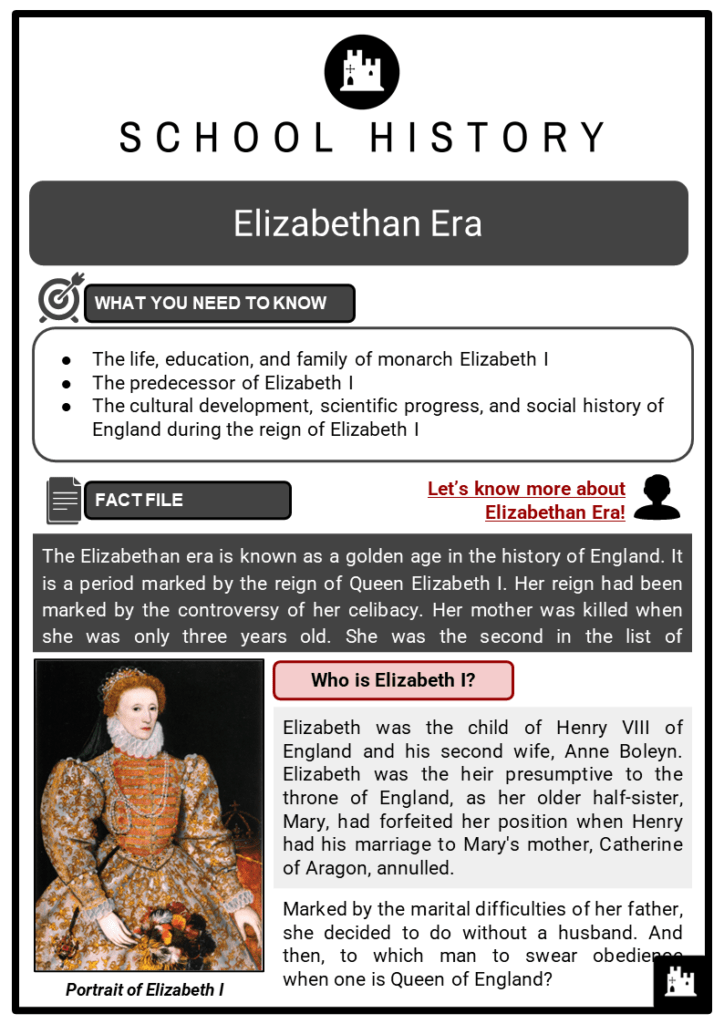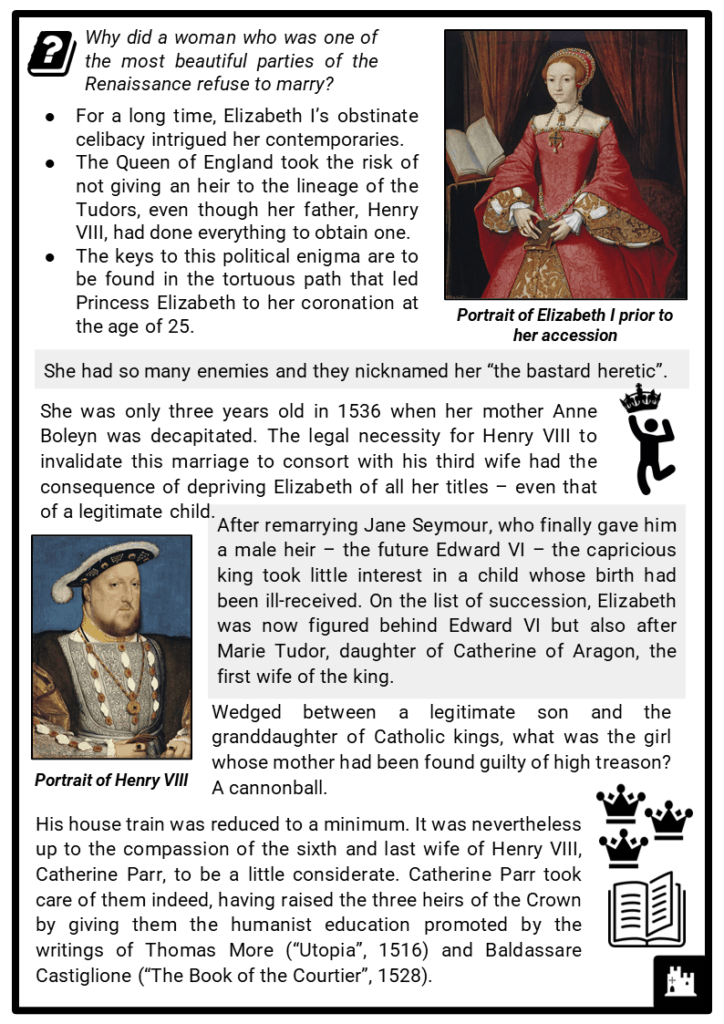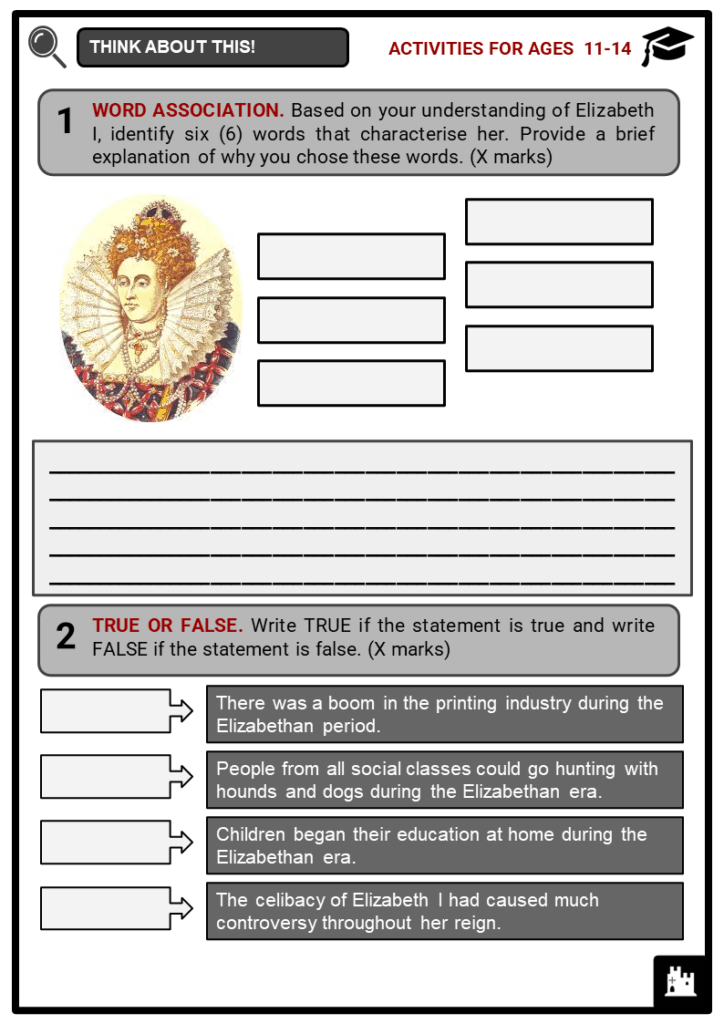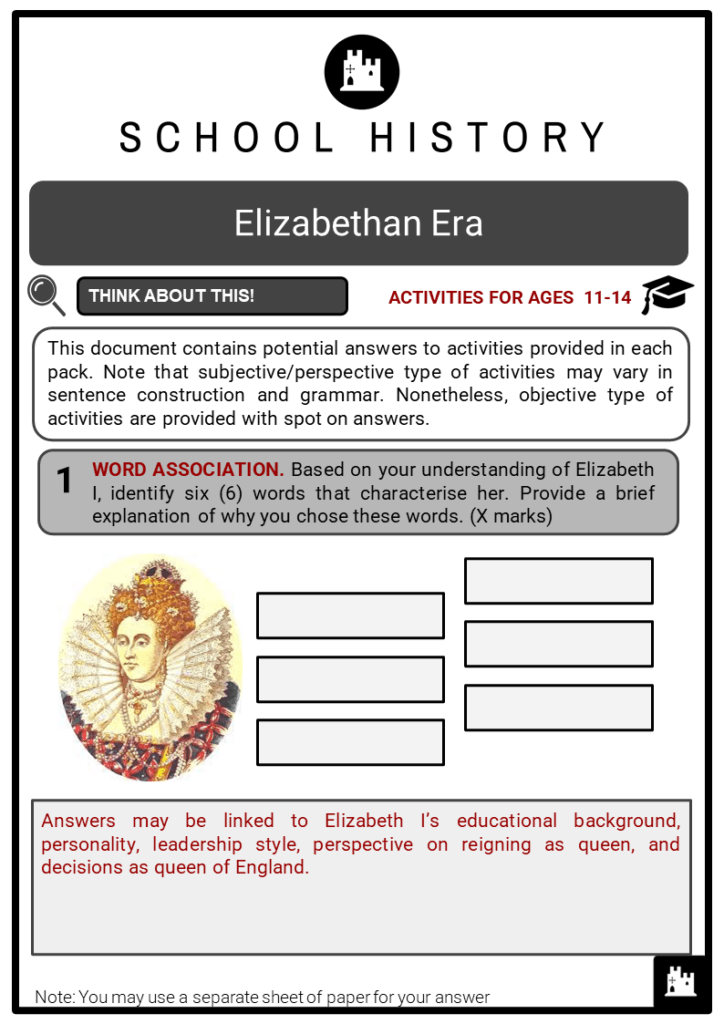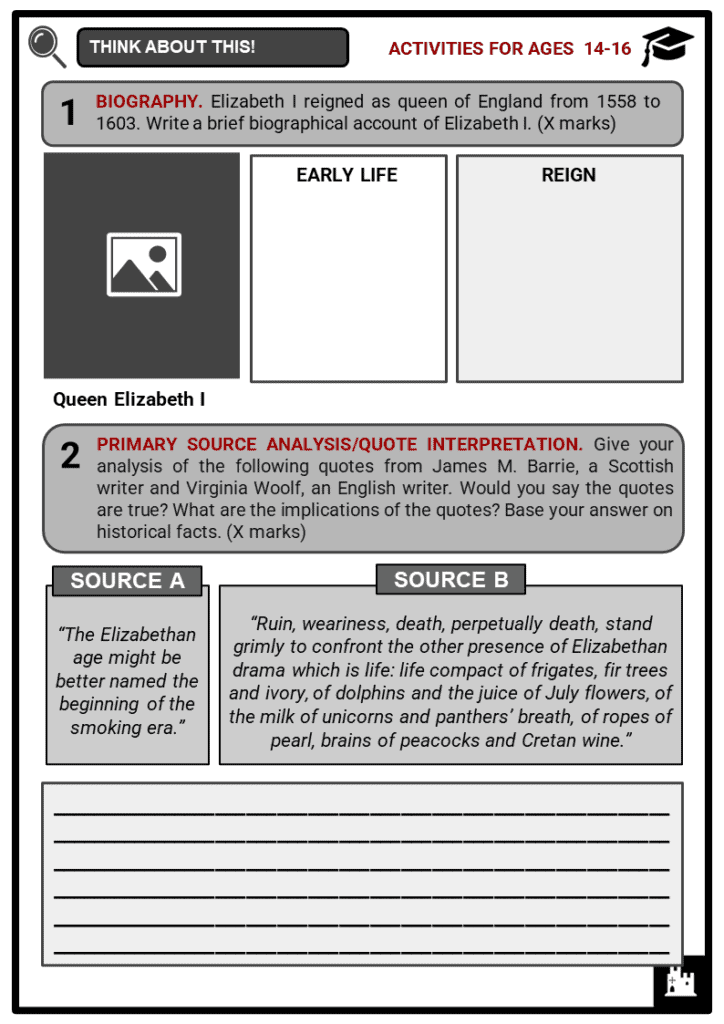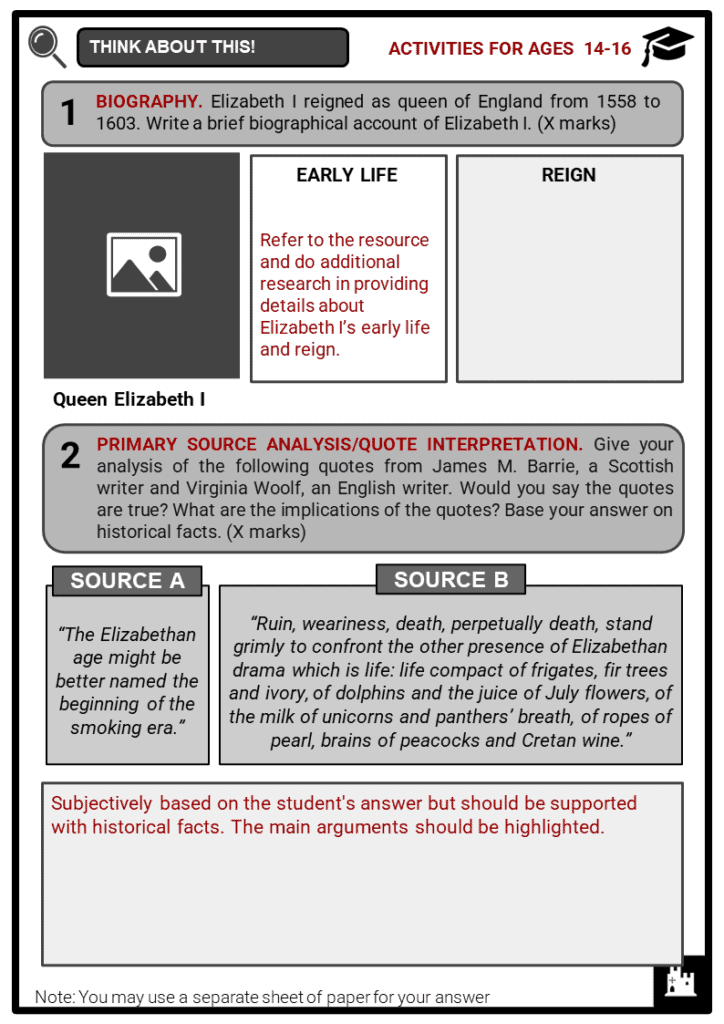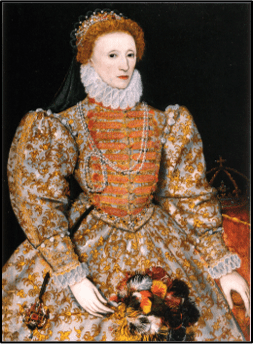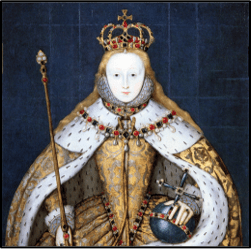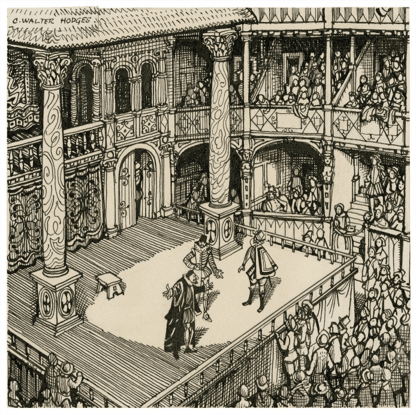Download Elizabethan Era Worksheets
Do you want to save dozens of hours in time? Get your evenings and weekends back? Be able to teach Elizabethan Era to your students?
Our worksheet bundle includes a fact file and printable worksheets and student activities. Perfect for both the classroom and homeschooling!
Table of Contents
Add a header to begin generating the table of contents
Summary
- The life, education, and family of monarch Elizabeth I
- The predecessor of Elizabeth I
- The cultural development, scientific progress, and social history of England during the reign of Elizabeth I
Key Facts And Information
Let’s know more about Elizabethan Era!
- The Elizabethan era is known as a golden age in the history of England. It is a period marked by the reign of Queen Elizabeth I. Her reign had been marked by the controversy of her celibacy. Her mother was killed when she was only three years old. She was the second in the list of succession.
Who is Elizabeth I?
- Elizabeth was the child of Henry VIII of England and his second wife, Anne Boleyn. Elizabeth was the heir presumptive to the throne of England, as her older half-sister, Mary, had forfeited her position when Henry had his marriage to Mary's mother, Catherine of Aragon, annulled.
- Marked by the marital difficulties of her father, she decided to do without a husband. And then, to which man to swear obedience
when one is Queen of England? - For a long time, Elizabeth I’s obstinate celibacy intrigued her contemporaries.
- The Queen of England took the risk of not giving an heir to the lineage of the Tudors, even though her father, Henry VIII, had done everything to obtain one.
- The keys to this political enigma are to be found in the tortuous path that led Princess Elizabeth to her coronation at the age of 25.
- She had so many enemies and they nicknamed her “the bastard heretic”.
- She was only three years old in 1536 when her mother Anne Boleyn was decapitated. The legal necessity for Henry VIII to invalidate this marriage to consort with his third wife had the consequence of depriving Elizabeth of all her titles – even that of a legitimate child.
- After remarrying Jane Seymour, who finally gave him a male heir – the future Edward VI – the capricious king took little interest in a child whose birth had been ill-received. On the list of succession, Elizabeth was now figured behind Edward VI but also after Marie Tudor, daughter of Catherine of Aragon, the first wife of the king.
- Wedged between a legitimate son and the granddaughter of Catholic kings, what was the girl whose mother had been found guilty of high treason? A cannonball.
- His house train was reduced to a minimum. It was nevertheless up to the compassion of the sixth and last wife of Henry VIII, Catherine Parr, to be a little considerate. Catherine Parr took care of them indeed, having raised the three heirs of the Crown by giving them the humanist education promoted by the writings of Thomas More (“Utopia”, 1516) and Baldassare Castiglione (“The Book of the Courtier”, 1528).
- After the death of the king, thirteen-year-old Elizabeth was at the heart of the intrigues led by the Seymour family.
- Catherine Parr had soon remarried Lord Admiral Thomas Seymour, the uncle of the sickly young king.
- Edward Seymour, elder brother of Thomas and lord-protector of England, dominated him, the Council of Regency.
- After the untimely death of Catherine in September 1548, Thomas wanted to marry Elizabeth this time.
- He made a habit of appearing lightly in the teenager’s room. Rumours circulated, stating Elizabeth was pregnant. Elizabeth had to submit her virginity to a humiliating examination to counter the rumours. The admiral braggart, who was trading with British privateers and diverting beautiful shares of loot, finally lost his head in 1549.
Mary Tudor: Predecessor of Elizabeth I
- Elizabeth succeeded Mary Tudor, who was nicknamed “the Bloody Mary” - a nickname given to her by Protestant opponents.
- In 1553, Edward VI died of pneumonia at the age of 15 years. It is thus Mary Tudor who girded the crown of England and Ireland as the second in the line of succession.
- She too had hardly been considered by her father. A fervent Catholic, she had not been allowed to join her mother, Catherine of Aragon, in agony. Emotional exile and humiliation had marked her youth, Henry and Anne Boleyn making her pay the price of the interminable lawsuit for annulment of the first marriage of the king.
- Upon the accession to the throne of Mary I, the country was plagued by religious quarrels and plunged into dark hours. The queen sealed the reconciliation of the English crown with the papacy and married the son of Charles V, the future Philip II of Spain.
- The pyres for the heretics were rekindled, which earned the sovereign the sinister nickname “Bloody Mary”. Then, at the end of a nervous pregnancy, which turned out to be the first sign of ovarian cancer, she went into agony on November 15, 1558.
- In 1558, the Duke of Norfolk attempted to behead her.
- At that moment, Elizabeth’s fate was suspended by a royal signature. Under the reign of Mary, the bastard and Protestant Elizabeth had become a symbol of the fight against the papist reaction.
- Suspecting at least two plots, the queen had her imprisoned in the Tower of London. It had
to be eliminated in order to restore the old
order and definitely bring the rebel England
back into the bosom of Catholicism. - The Duke of Norfolk attempted to snatch from the dying queen the initials authorizing the decapitation of Elizabeth. But Mary refused to commit this sin against a half-sister.
Female Royalty
- On January 15, 1559, Anne Boleyn’s daughter was crowned in Westminster Abbey; a monstrosity for many subjects. Bernard Cottret, author of an illuminating analysis of this “female royalty” (Fayard, 2009), underlines the scandal that then represented the reigns of women: “For the time, it is an anomaly in a natural order dominated by the males”.
- It was necessary to prevent the kingdom from falling down, in the words of the sixteenth-century lawyer Etienne Pasquier.
- In France, jurists had avoided this risk by promulgating the Salic law, which only homologated the succession from father to son, or even to a more distant relative, provided he was a male.
- The reason for this “sexual discrimination” was a dilemma: the sovereign must perpetuate the lineage. But with who? The Queen in obedience to her husband, if she were to marry a foreign prince, what would happen if it was a Habsburg or a Valois, these false friends of England, a small kingdom caught between Spain and France?
- Mary Tudor was well aware of this risk when she married Philip II. She had specified that the territorial rights of the sovereign would be extinguished with the death of the queen.
A Cultural Explosion
- Like her father before her, Elizabeth had received a high-quality
She spoke, besides English, Latin, Greek, Italian and
French. The practice of ancient languages was then virtuosity. - Elizabeth transcribed, from French to English, “The Mirror of the Sinful Soul” of Marguerite de Navarre, the sister of Francis I, as a gift to her stepmother Catherine Parr in 1545. Recluse under the reign of Mary Tudor, she read the “Psalms of David” and Cicero in the text.
- She also wrote poetry. In this, Elizabeth was the worthy representative of her kingdom. Upset during her reign by an unprecedented cultural explosion, which first passed by the affirmation of a language, she declaimed at the theatre and sung at mass.
- The Anglican reform caused a rise of religious music through the psalms sung in “Book of Common Prayer”, the official book for the daily worship of all.
- William Byrd, Orlando Gibbons, Robert White, and Thomas Tallis were thus the glorious composers of Elizabeth’s reign. At the same time, the art of the sonnet, coming from Italy, found new masters in the form of John Lily, Philip Sidney, Edmund Spenser and, of course, William Shakespeare.
- But, the most striking manifestation of the “Elizabethan Golden Age” was undoubtedly the birth of modern theatre. How to explain the emergence in a generation of genius playwrights such as Ben Jonson, Christopher Marlowe (the author in 1588 of “The Tragic History of Dr. Faust”) and Shakespeare?
By an extraordinary demographic and economic convergence. - The population of London had increased from 50,000 in 1520 to 200,000 in 1600. Focusing on the country’s commercial activity, the capital of the kingdom drained the forces of the countryside. Half of the urban population was under 20 years old.
- And though life expectancy remained low, ambitions were raised, especially in a merchant class that began to challenge the privileges of the old nobility.
- As a tool of social climbing, education became increased in value. In certain colleges, around the sons of the gentry, there was now a considerable proportion of offspring of lawyers and merchants, but also of labourers and other lower classes.
The Boom in the Printing Industry
- The boom in printing was obviously paramount. Some 5,000 titles had been published in the eighty-seven years preceding Elizabeth’s accession. Around 7,130 titles were printed during the forty-five years of Elizabeth’s reign (1558-1603).
- Private libraries were growing. Latin, Greek, and French remained essential subjects of instruction. Many scholarly works were also translated into the national language.
- The new culture was primarily English. It was at the theatre, which then took its modern form, that it was crowned. This sentence of Elizabeth is related: “We, the princes, are installed on a stage at the sight of the world” – echo the famous “the world is a scene” (“the world is a stage”) of Shakespeare.
Scientific Progress
- There had been significant progress in the sciences during the Scientific Era, particularly with navigation, cartography, and surveying.
- Sir Francis Drake, an English explorer, circumnavigated the globe in a single expedition between 1577 and 1581
- Sir Martin Frobisher explored the Arctic and went on three voyages to the New World in search for the North-west Passage.
- John Dee, who was the court astronomer for Elizabeth I, advocated for the establishment of colonies in the New World.
- Notable astronomers who advanced navigation and cartography were Thomas Harriot and Thomas Digges.
Social History
- There were no famines during the Elizabethan era. England's food supply was abundant throughout. One’s diet in England during the Elizabethan era depended on their social class. The rich consumed white bread, while the poor ate dark bread. Meat, fruits, and vegetables could only be afforded by the rich. People drank beer because water was impure to drink more often than not.
- A variety of sports and entertainment were enjoyed during the Elizabethan era. Only the rich could go hunting with their trained hounds and dogs. The upper classes engaged in jousting and fencing.
- Animal sports, such as cock fighting, dog fighting, and bull baiting, were also popular.
- Children began their education at home, starting with basic etiquette. Boys were required to study in grammar schools. Girls were mostly not sent to school, and if ever were only allowed to attend petty schools. The rich often opted for private tutors for their children.
- Important festivals held during the Elizabethan era included:
- Plough Monday, which is the first Monday after Twelfth Night of January, celebrated returning to work after the Christmas festivities.
- Shrove Tuesday is the day before Ash Wednesday.
- May Day, observed on the first day of May, celebrated the first day of summer.
- Accession Day, also known as Queen's Day, was observed on November 17 and celebrated the anniversary of Queen Elizabeth's accession to the throne.
Image sources:

